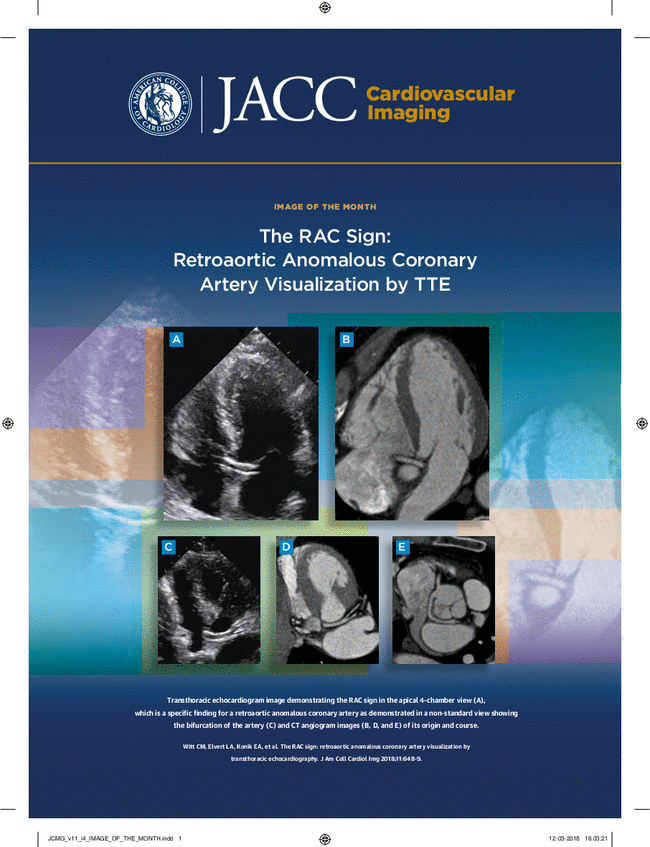18F-FAPI-42 PET检测扩张型心肌病心肌成纤维细胞活化与组织病理学和CMR的比较。
IF 15.2
1区 医学
Q1 CARDIAC & CARDIOVASCULAR SYSTEMS
引用次数: 0
摘要
背景:心肌纤维化(MF)是扩张型心肌病(DCM)的一个关键病理生理特征。靶向成纤维细胞活化蛋白(FAP)的放射标记显像剂可提高检测早期心肌纤维化的准确性和敏感性。目的本研究旨在评价18f标记FAP抑制剂示踪剂(FAPI-42)正电子发射断层扫描(PET)成像检测DCM患者心肌成纤维细胞活化和纤维化的可行性。方法19例DCM患者行18F-FAPI-42 PET/计算机断层扫描,14例行心脏PET/心脏磁共振(CMR)扫描。4例患者在PET扫描后9至124天内接受了心脏移植。建立对照组18F-FAPI活性和CMR参数的正常范围。Spearman相关分析评估了18F-FAPI摄取、胶原纤维沉积程度和FAP荧光、超声心动图心功能参数和PET/CMR之间的相关性。结果18f -FAPI PET成像显示DCM患者心肌不同区域FAPI摄取程度不同,显著高于对照组。18F-FAPI-42 PET比CMR-LGE (n = 95)鉴定出更多的异常段(n = 168)。此外,fapi阳性节段t1 -对比后值和细胞外体积%均高于fapi阴性节段(n = 56)。心肌长轴径向PS%容量受损更为严重。在心脏移植患者中,FAPI摄取与FAP平均荧光强度(P < 0.001)和胶原纤维沉积(P < 0.05)密切相关。FAPI摄取也与CMR评估的心功能参数(收缩末容积、舒张末容积、左室射血分数%和细胞外容积%)相关。随着NYHA功能等级从Ⅱ到Ⅳ的进展,代谢活性体积持续增加。然而,最大标准化摄取值和病灶总FAPI先升高后下降。结论s18f - fapi PET能够检测DCM心肌成纤维细胞的活化情况,且与组织学指标和心功能参数密切相关。代谢活性体积是评估DCM病情的有效指标,而最大标准化摄取值和病变总FAPI可能具有潜在的预后价值。本文章由计算机程序翻译,如有差异,请以英文原文为准。
Comparison of 18F-FAPI-42 PET for Detecting Cardiac Fibroblast Activation in Dilated Cardiomyopathy With Histopathology and CMR
Background
Myocardial fibrosis (MF) is a key pathophysiological characteristic of dilated cardiomyopathy (DCM). Radiolabeled imaging agents targeting fibroblast activation protein (FAP) enhance the accuracy and sensitivity for detecting early-stage myocardial fibrosis.
Objectives
This study aimed to evaluate the feasibility of using 18F-labeled FAP inhibitor tracer (FAPI-42) positron emission tomography (PET) imaging for detecting myocardial fibroblast activation and fibrosis in DCM patients.
Methods
In total, 19 DCM patients underwent 18F-FAPI-42 PET/computed tomography imaging, with 14 also underwent cardiac PET/cardiac magnetic resonance (CMR). Four patients underwent cardiac transplantation within 9 to 124 days after PET scans. Control groups were enrolled to establish the normal range of 18F-FAPI activity and CMR parameters. Spearman correlation analysis assessed correlations between 18F-FAPI uptake, the degree of collagen fiber deposition and FAP fluorescence, cardiac function parameters obtained from echocardiography, and PET/CMR.
Results
18F-FAPI PET imaging revealed varying degrees of FAPI uptake across diverse regions of the myocardium in DCM patients, significantly higher than the control group. 18F-FAPI-42 PET identified more abnormal segments (n = 168) than CMR-LGE (n = 95). Furthermore, in FAPI-positive segments, the T1-postcontrast values and extracellular volume % were higher than in FAPI-negative segments (n = 56). Additionally, the myocardial long-axis radial PS% capacity was more severely impaired. In heart transplant patients, the FAPI uptake strongly correlated with FAP mean fluorescence intensity (P < 0.001) and collagen fiber deposition (P < 0.05). The FAPI uptake also correlated with cardiac function parameters assessed by CMR (end-systolic volume, end-diastolic volume, left ventricular ejection fraction %, and extracellular volume %). As NYHA functional class progressed from Ⅱ to Ⅳ, metabolically active volume increased consistently. However, maximum standardized uptake value and total lesion FAPI initially increasing and then subsequently declining.
Conclusions
18F-FAPI PET is capable of detecting fibroblast activation in the myocardium of DCM, strongly correlating with histological markers and cardiac function parameters. Metabolically active volume is an effective indicator for assessing the condition of DCM, whereas maximum standardized uptake value and total lesion FAPI may potentially offer prognosis values.
求助全文
通过发布文献求助,成功后即可免费获取论文全文。
去求助
来源期刊

JACC. Cardiovascular imaging
CARDIAC & CARDIOVASCULAR SYSTEMS-RADIOLOGY, NUCLEAR MEDICINE & MEDICAL IMAGING
CiteScore
24.90
自引率
5.70%
发文量
330
审稿时长
4-8 weeks
期刊介绍:
JACC: Cardiovascular Imaging, part of the prestigious Journal of the American College of Cardiology (JACC) family, offers readers a comprehensive perspective on all aspects of cardiovascular imaging. This specialist journal covers original clinical research on both non-invasive and invasive imaging techniques, including echocardiography, CT, CMR, nuclear, optical imaging, and cine-angiography.
JACC. Cardiovascular imaging highlights advances in basic science and molecular imaging that are expected to significantly impact clinical practice in the next decade. This influence encompasses improvements in diagnostic performance, enhanced understanding of the pathogenetic basis of diseases, and advancements in therapy.
In addition to cutting-edge research,the content of JACC: Cardiovascular Imaging emphasizes practical aspects for the practicing cardiologist, including advocacy and practice management.The journal also features state-of-the-art reviews, ensuring a well-rounded and insightful resource for professionals in the field of cardiovascular imaging.
 求助内容:
求助内容: 应助结果提醒方式:
应助结果提醒方式:


